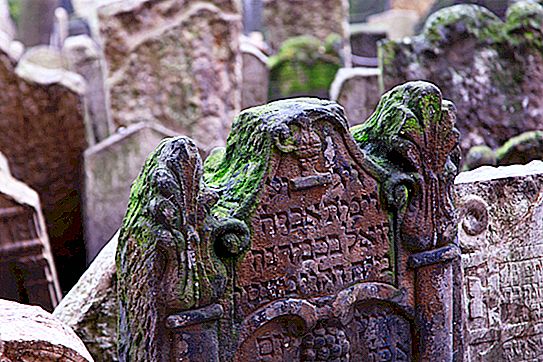In the Czech Republic there is a place that attracts all the mystics of Europe - this is the Old Jewish Cemetery. In the heart of the capital is the Jewish Quarter, which only in 1850 became part of Prague. Within a limited ghetto, in one place for several centuries, the dead were buried. Historians estimate that there are about 200 thousand graves and 12 thousand gravestones on the graveyard.
Official story
Until 1478, the Jewish cemetery was located in the Nove Mesto district; it was demolished at the request of the townspeople under King Vladislav II. In what year the famous churchyard was founded is unknown. The oldest tombstone found in the cemetery dates back to 1439, underneath lies the Prague rabbi, poet Avigdor Kara.
The old Jewish cemetery makes an unprepared person a frightening impression by piling tombstones on a small plot of land. Strange at first glance, the attitude to the graves of their ancestors has its own explanation. For a long time, the Jews of Prague did not have the right to bury the dead outside the ghetto, therefore for more than three centuries thousands of deceased found the last refuge on one piece of land.
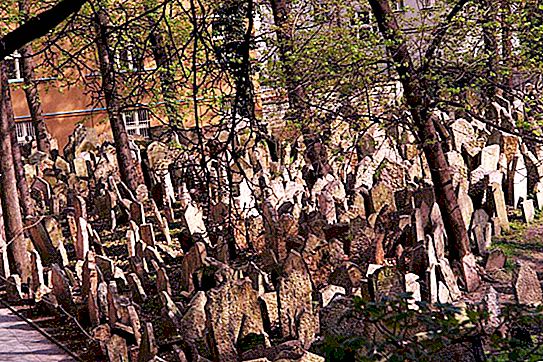
Modest in size, the Old Jewish Cemetery is much larger than its visible part. According to religious canons, it is impossible to destroy graves and gravestones, therefore the burial has a multilayer structure. A fresh coffin was installed on top of the previous one, only slightly sprinkled with earth, so as not to injure the psyche too much and observe decency. Burying their loved ones, the Jews took care that the tombstones remained visible, installing new slabs next to old ones.
Guess the story
For several centuries, the Old Jewish Cemetery in Prague has turned into a necropolis, where, according to inaccurate estimates, more than 200 thousand people are buried - this is a very approximate figure, many believe that they are many times more. Some experts believe that the churchyard has 12 layers. The exact number of visible tombstones is known - 12 thousand. Monuments are of artistic and historical value of different ages - people were buried here from 1439 until 1787, after which a ban was placed on burials inside settlements.
It is believed that the Old Jewish Cemetery in Prague (Czech Republic) arose between the 13th and 14th centuries, when the residents of the ghetto reburied their ancestors, collecting the remains from all the city’s Semitic graveyards. According to tradition, the stones of the oldest cemetery were preserved - they were installed in the cemetery fence. Due to the non-trivial location of the tombstones, a legend has been circulating around Prague since these monuments belong to suicides and people who cursed their parents.

There are legends that the Old Jewish Cemetery in the Czech Republic appeared long before the founding of the city, and it was still in the reign of Borzhivoy. Proponents of the idea refer to the fact that on some tombstones three-digit dates are carved, for example, 941, 606 and others, no less ancient. They say that on the graveyard lies the remains of a Jewess who died a hundred years before the founding of Prague. But knowledgeable people claim that the records simply do not have one figure, which was done intentionally. The inhabitants of the ghetto specially carved out so ancient dates on the stones that the crusaders did not ruin the graves.
What did the poet write about?
Jews often call cemeteries gardens. When the first person who died in the ghetto was buried, nobody knows, and for sure, information about this has not been preserved. Historians rely on factual evidence. Judging by them, the oldest grave belongs to Avigdor Kara, buried in April 1439. He was a rabbi and poet. He wrote the lines about the ruin and robbery in the ghetto, which described the abuse of the old Jewish cemetery. History is silent about what kind of graveyard we are talking about in a psalm written by Kar in 1389.
Tombstones and burial grounds are an encyclopedia of symbolism, spanning several eras - from the Middle Ages to the Renaissance. The carved reliefs are an illustration of the sacred knowledge of the Torah, Talmud and other secret books. During the reign of King Rudolph II, the patron of the arts and sciences, the ghetto flourished, giving the country scientists, architects, and philanthropists. These people have monuments in the garden of sorrow.
Stories on the stones
Each stone of the necropolis silently tells stories about long-departed people, how relatives loved them, what good they did for the community. Above the ashes of David Hans, the author of Universal History, an expert on mathematics and astrology, the star of David shines and the symbol of Prague, the goose, flaunts. This is a sign of memory to the scientist from his people and city.
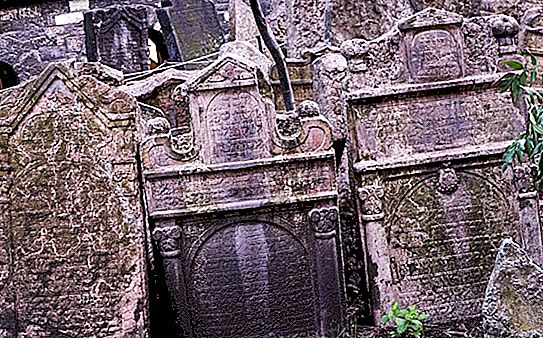
At the Old Jewish Cemetery, a tribute is paid to the head of the local community, Mordechai Maisel, who died in 1601. He made a huge contribution to the prosperity of the ghetto, built a synagogue, and still bearing his name. According to legend, he received his wealth thanks to some kind of treasure, which was presented to him by devils.
According to legend, the Queen of Poland was buried in the Old Jewish Cemetery. Its tombstone is easy to recognize, it is carved from marble, decorated with monograms, coat of arms. The name, carved in stone, indicates that under it lies Anna Handel, the wife of the first nobleman of Jewish descent. It is said that the name was changed specifically to protect the eternal peace of the exile from encroachment. Once from Poland her husband expelled her. Imbued with the fate of a wanderer, the Jews gave her a haven in the ghetto, and by the end of her life she converted to Judaism.
There are monuments to less famous citizens who left a good name about themselves. On one of the tombstones, the name of David Koref, who once held a butcher's shop, was engraved. He is known for feeding Prague orphans without making any difference in religion. On great holidays, David handed out to the poor as much meat as his children weighed.
Not far from him lies the mother of the Prague beggars - Mrs. Gendela. She made friends with scientists and did not disdain to sit at the same table with the poor, inviting them to her house to share dinner, and then gifting them with clothes, linen, shoes, taking care of orphans and shelters.
Rabbi lion
The legends of the Old Jewish Cemetery are inexhaustible. The most famous person buried in this garden is Rabbi Lev ben Betzalel (1512-1609). The creator of the Golem was not a mythical person, but a living person living in the ghetto. Strictly documented evidence was left about his life, and the wisdom of this husband, according to contemporaries, had no boundaries. Whether the clay giant was or was not created is unknown, although it has become one of the symbols of Prague, many other legends are associated with the name of Rabbi Lev.
One of them tells about the visionary gift of a sage. During the life of Ben Bezalel in Prague, an epidemic of the plague occurred, and one of its features was that a terrible death claimed the lives of only Jewish children. Prayers and tears did not save. Once, a rabbi had a dream in which the prophet Elijah brought him to the Old Jewish Cemetery. The priest saw small children emerge from the graves and frolic in the garden.
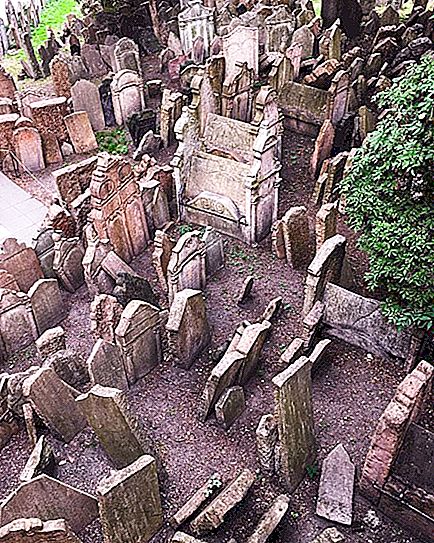
Waking up, the rabbi told his student to go to the cemetery with the sunset and, having waited for the children, to tear off the shroud from one of them and bring it. The student completed the task, returning with prey. Then he was again sent to the churchyard to see how events would develop. An hour after midnight, a flock of children went to their graves - all but one, from which the shroud was torn. The child could not go back and therefore turned to the student with a request to return the robe to him, to which he was promised that if he went to Rabbi Lev and told him everything that he would ask him, the shroud would immediately return to the owner.
The little ghost said that the plague is a curse, and the fault is two sinners who kill their only born children. The kid named their names and, having received a shroud, went to a place of rest. In the morning, Lev ben Betzalel gathered advice and called to account these women, as well as their husbands. According to the verdict, the criminals were transferred to a court of secular authorities, where they received the full punishment. From that moment, child deaths stopped, the epidemic subsided.
One of the most notable monuments stands above the grave of a sage and a scientist, it is not difficult to find it, it is strewn with pebbles, a sign is installed nearby.
Ghetto Remediation
With the onset of the 18th century, tombstones began to be decorated with ornaments, symbols that denoted the origin, social status, profession of the deceased, and the names and surnames of the buried appeared. During the reign of Franz II, the first attempts were made to demolish the Old Jewish Cemetery, but then failed to do this, thanks to the intercession of Archbishop Vaclav Hlumchansky.
The reduction of the cemetery still happened, it happened at the end of the 19th century. Part of the territory was transferred to the city, and now streets lie on the site of the mournful garden, and part of the churchyard was given over to the Museum of Decorative Arts. As part of the work, a wall was built around the Old Jewish Cemetery. Tombstones from the liquidated territories are now part of the cemetery fence, the remains of the deceased were reburied near the Klausova synagogue.
Modernity
The old Jewish cemetery, although not operational, attracts a huge flow of tourists. Since 1975, leisurely restoration work has been carried out on the territory of the necropolis. The ceremonial hall, built in 1906, is located near the main entrance, and there is an exposition of children's drawings of former prisoners of the Terezin concentration camp.
One of the sights of the Old Jewish Cemetery and a symbol of Prague is the Old-New Synagogue - the oldest functioning Jewish temple. The story about her begins with the legend that the building was transferred to the Czech Republic on its wings by the angels from Jerusalem itself. Putting the house of worship on the old foundation of the long-destroyed cult Jewish temple, they strictly ordered never to repair or change anything in the synagogue.
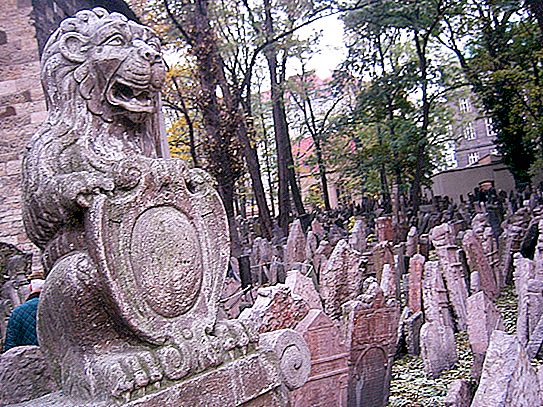
Old-timers say that sometimes repairs were carried out - the walls were tinted, several tiles were replaced, but the workers who performed these works died very quickly. They also say that in the attic of this synagogue, Rabbi Leo imprisoned the Golem, and he is still there, waiting for someone who can revive him.
Everyone can enter the territory and take a photo of the Old Jewish Cemetery in Prague. For tourists, the entrance is open from nine in the morning until half past four in the evening, the day off is Saturday. The necropolis is closed to the public during Jewish holidays. Entrance fee - 330 CZK (955 rubles). The cemetery is located in the district of Josefov, Parizhska Street, 934/2.

